Contents
- 1About Barefoot Ken Bob Saxton
- 1.1At Work
- 1.2Guru of Barefoot Running
- 1.3Not a "Real" Runner
- 1.4Racing
- 1.5Winter Running Barefoot
- 1.6Videos
- 1.7Sound Bites:
- 1.8Statistics
- 2Barefoot Injuries??
- 2.1Don't your Feet get Cut Open Frequently?
- 2.2What injuries caused by shoes?
- 2.3The Fear Factor!
- 2.4The Reality
- 2.5Notable* Injuries from Running Barefoot
- 2.6Notes
- 3Gallery
- 4Contact
About Barefoot Ken Bob Saxton
At Work
In addition to founding Ken Bob’s Original Ken Bob’s Original BarefootRunning.com website website in 1997, Ken Bob Saxton has also been an Equipment Technician in the Electrical Engineering Department (EE), and later an Information Technology Consultant in the Computer Engineering and Computer Science (CECS) department at California State University, Long Beach (CSULB). In addition, he was also a Multi-Media Specialist and Technical Adviser for the College of Engineering (COE). Ken Bob was also Web Development team leader for the College of Engineering. But that’s just how he earned a living. He retired from CSULB in 2017. However, in addition to all of that…
Guru of Barefoot Running
Ken Bob Saxton is the leading instructor of barefoot running in the United States of America, featured on ABC World News (2005), NPR, Runner’s World magazine, The New York Times, and many other newspapers, magazines, radio, and television appearances/mentions locally and around the world, as well as being acknowledged as the “great bearded sage” of barefoot running in the bestseller Born to Run, by Chris McDougall, who calls Ken Bob “The Master of Barefoot Running.”
Not a “Real” Runner
Ken Bob does not consider himself a “real” runner. “I’m not addicted, and nowadays, I only run a few miles at a time, a few time each week. I rarely even race anymore – entry fees have more than doubled in 20 years, and my income (like many folks) has only grown a couple percent.”
At age 68 in 2023, Ken Bob is mostly walking (mostly barefoot), with short sprints when his Siberian Husky sees a squirrel, or while crossing the street with cars trying to run over anyone in the crosswalk.
Ken Bob and his wife, Cathy, and their dog, Katin (Siberian Husky) still occasionally “run” (but mostly walk) 5K events. Ken and the dog both barefoot. The dog, however is mathematically twice as barefoot as Ken Bob (because he has 4 feet and Ken Bob only 2).
Racing
Despite not being a “real” runner, Ken Bob has completed more than 400 races barefoot, including 79 marathons barefoot (and one marathon in shoes), and one ultra-marathon (50+ kilometers). Ken Bob has qualified for the Boston Marathon several times and “run” it twice. He enjoyed completing an astounding marathon-a-month challenge in 2004 (totaling 13 marathons), which he topped with 14 marathons in 2006, including 4 marathons in a 15-day period–all barefoot.
Ken Bob has run tens of thousands of miles barefoot, just for fun, since the early 1960s; no precise data available, since most of the running was just for fun, and even though Ken Bob started keeping a running log in 1998, he stopped logging his milage 10 years later, because “it wasn’t fun!” The only reason he started a log in the first place, was because people kept asking him things like, “how far” and “how often” you run barefoot. Now that there are many other barefoot runners, some of whom LOVE keeping those kind of statistics, I’ll leave that chore to those who love it (or are addicted to it).
“Barefoot” Ken Bob, as he is popularly known, has helped thousands of people across the United States in-person at his “Play-Fun-Shops” (clinics/workshops) and educated thousands of new barefoot runners on planet Earth, from Mumbai to Oslo, via his popular website at BarefootRunning.com – which is the original Running Barefoot website (founded by Barefoot Ken Bob in 1997). Also, many folks from around the world enjoy going to Southern California for one (or more) of Ken Bob’s Regular Runs and Play-Fun-Shops (because workshop sounds too much like work, and clinic is too clinical). Shoes are optional – but most people are easily convinced they won’t need shoes by Ken Bob’s reasoning (and it rarely freezes here).
Winter Running Barefoot
Ken Bob lives on the coast in southern California. The Pacific Ocean provides an excellent heat sink, keeping summers moderately warm, and winters moderately cool (rarely freezes).
On the coldest winter days, I simply don’t run as early in the morning. Later in the morning when the temperatures are in the 60s or 70s walking barefoot is comfortable. Running barefoot can be comfortable into the 50s or lower (depending on several other factors)
Videos
Sound Bites:
- Organizer and Guru: Running Barefoot Tour (2013)
- Editorial Panel, Advisor, and Writer (2012) for The Natural Born Runner Magazine
- Organizer and Guru: Running Barefoot Tour (2012)
- Featured speaker (2012 August) at the Suggs Medical Symposium, Springfield IL
- Barefoot Running Step by Step (the book) sponsors (2011-2012) The Naked Foot 5K Series
- Co-author of Barefoot Running Step by Step (2011) with Roy M. Wallack
- Senior Adviser (2010), The Barefoot Runners Society
- Barefoot Running Guru (2010-present) for The Barefoot Runners Society
- President (2010-present) Los Angeles area chapter of The Barefoot Runners Society
- Organizer and Guru: Running Barefoot Tour 2010
- Completed 79 Marathons Barefoot (1998 – 2012) plus one (with shoes) in 1987
- Mentioned or appeared in Runner’s World Magazine at least 4 times (1999 – 2010)
- Organizer and Guru: Running Barefoot Tour (2008)
- Featured in Sneaker Confidential (2006) Canadian Broadcasting Company
- Featured in Happy Feet (2005 November 5) ABC World News
- Featured in The Ballad of the Barefoot Runner (2004 August) Rosen KUTV
- Organizer and Guru: Running Barefoot Tour 2003
- Interviewed (for about 15 seconds) at the Los Angeles Marathon (2001 March 4) TV-13
- Featured in The Science of Trainers (2000) twentytwenty tv
- Founder and webmaster of the Running Barefoot website (1997)
Statistics
- (1955) Born in Traverse City, Michigan
- (1957?) Running Barefoot since childhood (at least occasionally)
- (1980) Moved to Southern California
- (1985) Began working at CSULB
- (1987) Ran a marathon in shoes, feet were blistered (except soles) and toenails turned black and fell off
- (1987) Began running nearly exclusively barefoot
- (1990) Began commuting to and from work (occasionally) by running/walking barefoot
- (1996) Began barefooting at work (equipment and computer technician)
- (1996) Began running long distance (16-22 miles) on hilly trails
- (1997) Ran first official barefoot race 10-miles on rocky trails
- (1997) Founded The Running Barefoot website
- (1998) Last (except when occasionally asked to evaluate new footwear products) long run (18 miles) in shoes – feet were bleeding afterwards
- (1999 October 23) 5-Kilometer Personal Record: 17:43 Newport Beach CA
- (1999 June 17) 5-Mile Personal Record: 30:18 Long Beach CA
- (1999 April 17) 10-Kilometer Personal Record: 37:02Seal Beach CA
- (1999 August 14) 10-Mile Personal Record: 1:02:11 Huntington Beach CA
- (1998 November 15) Half Marathon Personal Record: 1:22:14 Irvine CA
- (2000 January 30) Marathon Personal Record: 3:18:50 Huntington Beach CA
- (2005) short runs (less than 1 mile each) in Nike Free 5.0s to evaluate Nike’s attempt at a “Barefoot Shoe”
- (2011) Co-authored “Barefoot Running Step by Step” with Roy M. Wallack
Barefoot Injuries??
Don’t your Feet get Cut Open Frequently?
I’m often asked how often I injure my feet while running barefoot. Even more often, I am TOLD that I will injure my feet more often running barefoot! I haven’t found that to be the case – shoes actually did more frequent, and more severe and debilitating damage to my feet!
What injuries caused by shoes?
Unlike my barefoot injuries, far too much damage from shoes to list here (it would be far easier to recall the times that shoes were comfortable! (not that often). Besides relatively frequent and far more severe ankle sprains (compared to almost zero while barefoot), my feet were nearly constantly blistered all through grade school and high school. And the worst foot injury, or injuries, and actually both feet, all happened during my first marathon (and my only marathon with shoes) when my shoes left both my feet completely raw, except the soles. Also my toenails turned black, and during the following week, all my toenails fell off. I know, you’re going to tell me that is not unusual for marathoners, or that my shoes probably didn’t fit correctly.
Do any shoes fit “correctly”? Why should we expect toenails turning black and falling off as a natural part of running long distances?
Why is any injury considered “normal”?
First of all, I’ve rarely seen shoes shaped like my feet (my toes don’t point toward the center, and my outer toes don’t curve inward either. Secondly, these injuries almost never happen to barefoot runners and are completely unnecessary! I’ve completed 79 marathons barefoot (through 2011 January 16), including 13 in 2004, and 14 in 2006, and 4 marathons in 3 consecutive weekends, and 2 marathons in two consecutive days twice! Below, I have listed every memorable foot injury that happened to me while running barefoot including, but not only, in the dozens of marathons I’ve completed, but also in the more than 400 races (from 1/4 miles to over 30 miles) I have completed barefoot, and the tens of thousands of miles I have run barefoot in preparation for those races and just for enjoyment.
The Fear Factor!
We are constantly being told (mostly by people who haven’t really tried or studied running barefoot), that we should only run barefoot on “natural” terrain, like manicured golf courses, and groomed beaches. That “humans aren’t designed to run on hard modern surfaces with broken glass everywhere”!
What I have noticed during my 50+ years of running barefoot and more than a decade of racing barefoot, is the stuff we are warned about (hard modern surfaces, broken glass, impact, blisters) are over-exaggerated.
- Yes, modern surfaces are hard – so we land more gently (our soles tell us immediately if we don’t).
- Yes, there is broken glass (not “everywhere”) and most of it just lays there (as long as we’re not scuffing our feet along the ground, or trying to push our soles into the glass – which our bare soles would let us know immediately to change such mistakes in running technique).
- Yes, we probably land with too much impact while wearing cushioned shoes to run with the same technique while barefoot – but if we were barefoot, we would really WANT to land with less impact. And studies show that simply by removing our shoes, we do cut impact up to 50% IMMEDIATELY. What’s even cooler? Experienced runners land with no measurable impact (jolting, jarring, pounding, etc.) at all – just a gentle loading of our weight on the foot – in my case, less than two times my body weight.
The Reality
The natural terrains we are told might be okay for barefoot running (instead of “unnatural” roads that are nearly as hard as natural stone), are actually much more challenging for barefoot runners – which is the reason I recommend people beginning running barefoot, start out on hard rough terrain, like gravel trails, or rough asphalt. This not only discourages us from one of the most common errors – doing too much, too soon – it also encourages us to learn good gentle technique more quickly (so we can get on with running further, more frequently sooner – which may also help us become faster).
We are natural animals and as such, we should run on natural surfaces when practical. However, nature was never made up of only manicured golf courses and groomed beaches!
Many modern surfaces are almost too comfortable and too consistently smooth to run barefoot on for more than a few hundred miles at a time without some variation. And in most locations where we would want to run, there really isn’t broken glass “everywhere”. And in most cases broken glass is less annoying than running over granules of kitty litter-sized pebbles, which is not a serious problem for an experienced barefoot runner.
Natural beaches (ones that aren’t combed and groomed daily for tourists) are littered with broken clam shells (and yes, thanks to modern humans, broken beer bottles). The worse part is, it’s hiding just beneath the soft sand. Of course since the sand is soft, and experienced barefoot runners land gently, it rarely cuts our skin – but do watch out for the sting rays when you run in the water to cool off! However, the sharp litter below the surface on a sandy beach can be a serious hazard for newbies. So, if you’re just starting out running barefoot, start on hard, preferably rough, surface where you can see (and avoid) most of the more serious hazards.
Golf courses, and manicured lawns are not natural. The plains of Africa, North America, etc., are littered with broken rocks, the grass during the dry season is like running on toothpicks, and the ground is as hard as asphalt in many cases, and it’s very uneven and full of holes. But, I’m not complaining about natural terrain, just about the misconceptions people have about where the real hazards are. It’s actually the natural hazards that makes these terrains very challenging and stimulating places to run barefoot! You’ll learn more about running gently on a hard uneven surface than while running on golf courses. While it may not teach beginners much about running gently, smooth asphalt or concrete surfaces are among the most comfortable places to run barefoot , as long as we run gently.
Notable* Injuries from Running Barefoot
Here is a list of memorable injuries that I’ve “piled up” while Running Barefoot for 50+ years. As you see, even the most debilitating injuries only resulted in a day or two off from running, and that, often not necessarily because of the injury, but simply to rest after completing a very hilly trail marathon!
- 1992 West Palm Beach, Florida – cut bottom of little toe on something sharp hiding in grass on side of road. Ran another mile back to where I was staying. Washed my feet. Medical Treatment: put a band-aid on the toe. Didn’t run for a couple of days.
- 1995 ?? Stepped on a sting ray while running into the ocean. Stabbed me in the top of my little toe. Was able to run again 2 days later. Could have run sooner with the aid of a band-aid to keep the injury from breaking open again. No medical treatment
- 1998 April Napa Valley Trail Marathon – cut the side of one foot. Finished the marathon. The cut was so debilitating (or was it the 26.2 miles over mountainous trails?) that, I had to take a day off before running 20 miles 2 days later! Medical Treatment: occasional foot soak.
- 2001 September 30, Alive and Running 10K – kicked sand-hill on beach the day before. Torqued foot backwards. Heard “snap”. Possible fractured bone in foot, or strained tendon. No medical treatment. Following day raced 10K. Finished in 39:32. Good enough for 2nd in my age division, 12th overall. Foot only hurt when using poor running technique (pushing off). This injury left a bump on the top of my right foot, that stayed with me for more than 10 years. Finally in 2012 it began to break up, and shrink (possibly from flexing my foot more while climbing up and down a ladder while barefoot and doing some painting and remodeling inside my home). After a fun trail run on 2013 January 13, it looks like the bump may be almost completely gone … 2013 July 23 update: the bump has been coming and going during my recent road trip. Growing for a few days, then suddenly disappearing – especially after a day of extreme foot flexing (hiking rocky/rooty trail, or climbing ladder while painting home, etc.). Each time it does this, it seems a bit smaller.
- 2003 December 13, Venice Marina 10K run – tiny splinter of glass stuck in my foot. I stopped for a couple seconds to remove it, then passed everyone who had passed me while I was stopped. No medical treatment.
- 2003 May 24 Bayshore Marathon – Tiny blood blister on left little toe. Finished marathon (with a Boston qualifying time of 3:29:31) by adjusting my running technique to avoid further damage (gently lift the toes when landing). Medical treatment: foot soaks.
- 2004 September New Mexico Marathon – Tiny blood blister on one middle toe. Finished marathon by adjusting my running technique to avoid further damage (gently lift the toes when landing). Medical treatment: foot soaks.
- 2006 Lake Tahoe Marathon – superficial scratch on the sole of one foot in the arch, while showing some volunteers that I wasn’t worried about stepping on pine cones (that last pine cone was exceptionally rigid!) Finished the marathon, rested, and completed another marathon the following day. No medical treatment.
-
2007 July 29 San Francisco Marathon, Stubbed toe around mile 10. San Francisco CA. Completed marathon. No medical treatment
- 2009 November 4 Stubbed toe while running with A Runner’s Experience Club, Long Beach CA
- 2011 January 16 Rock ‘n’ Roll Marathon, Phoenix, Az. – glass splinter during the final tenth of a mile. Finished the marathon, pulled the splinter out, and didn’t run for two days (not because of the splinter, just to rest after the marathon). Medical treatment: foot soaks.
- 2011 March 20 Los Angeles Marathon, Los Angeles, Ca. -2 (two) glass splinters during the marathon (this is some kind of record, that’s as many glass splinters as I’ve picked up in ALL of my previous races combined! Still, neither was any problem. I simply stopped, and worked them out with my fingernail… actually came out fairly easy because the skin on the soles of my feet was nice and moist from the rain. Finished the marathon. No medical treatment.
- 2011 March 27 Running Barefoot Play-Fun-Shops, Huntington Beach, Ca. – one of my worst injuries yet, but I’m not sure what it was. Possibly a bee sting. Oddly it felt best while running, and worse while standing or walking. So we ran some more, then I went home and rested with my foot elevated, alternating with some soaking, and a couple miles of running each of the next couple of days. By the third day I was nearly fine. Medical treatment: Foot soaks.
- 2011 September 21, dreaded Cheetos hazard – may cause feet to turn a nasty orange color – until washed with water (might even require soap). Brooklyn, NY, No medical treatment.
- 2011 September 27 Brooklyn NY, running to Coney Island, small splinter of glass stuck in my foot, I pulled it out, and finished running. No noticeable signs of damage after finishing 3-mile run, soaking in the ocean for a bit, and running 3 miles back to where I was staying. No medical treatment.
- 2013 February 24 Chino Hills Fun Trail Run. Stepped on a branch with a thorn. Luckily it was a good sized branch and as I lifted my foot, the weight of the branch pulled the thorn out of my foot, and since there was blood, almost a whole drop of blood, which is one of my more significant foot injuries from running barefoot, I figured I’d better report it here. No medical treatment.
-

2014 May 31 twisted ankle, bruised foot – may be re-injury of sprain 24 years ago while running down stairs in shoes.
2014 May 31 Ken Bob’s Regular Run. twisted ankle, broke metatarsel running downhill fast on trails. Bruised foot – may be re-injury from 24 years ago while running down stairs in shoes. Walked very gently 1.5 miles back home. Then foot swelled up, and started really hurting, to let me know it was time to rest for a while. X-Ray revealed crack in small metatarsal – very common injury, even in shoes.
Notes
* Sorry, these are only the “injuries” I can remember, though not all are really what I would consider “notable” except for the fact that they aren’t really notable… though I suppose, given the fact that I’ve noted them here, they must be “notable”.
I did not include injuries sustained from things like falling down, running into trees, being pushed through a garage door by a fire truck, bending one knee backwards, etc. because these kinds of injuries can happen at least as much to someone wearing shoes – in fact I was wearing shoes (or other footwear) during most of those types of injuries, even when the fire truck pushed me through the garage door (that story isn’t as interesting as it should be, especially since the truck only knocked the wind out of me). I accidentally tried to bend my knee backwards when I collided with a snowbank while being pulled by a horse on skis … how the horse got on skis, I’ll never know. I was wearing ski-boots at the time, which is why my knee tried to bend backwards, instead of my ankle bending naturally forward.
Most (actually, ALL) of the injuries I’ve “suffered” while running barefoot required no medical treatment at all – other than washing my feet – which I do even when they’re not “injured” or in “extreme” cases, soaking, either in the ocean, or Doc Wolfe’s Aching Feet Soup.
Gallery
- Ken Bob Saxton 2003 July 5 Chester 4 on the 4th, Middletown Press CN
- Ken Bob Saxton 2003 May 24 Bayshore Marathon
- Barefoot Ken Bob (in purple) 2009 November 15 Malibu Marathon CA
- Barefoot Ken Bob
Contact
This contact form is for publicity contacts (journalists, etc.), invites for barefoot running guest speakers, offers of sponsorship, RSVPs to events, or if you just want to go for a walk/run with Barefoot Ken Bob and his dog (whenever you happen to be near Sunset Beach California), etc..
If you have questions, answers, comments, stories, etc. related to running barefoot, or are curious why you got injured by running in “barefoot shoes”, please share publicly to benefit from, and add to our global knowledge base about barefoot running. This idea of sharing our stories, questions, comments, etc. is the reason Barefoot Ken Bob Saxton established the original Running Barefoot website in 1997.
The Running Barefoot Forum (includes links tor other Barefoot Running information)



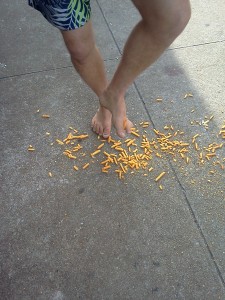
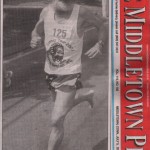

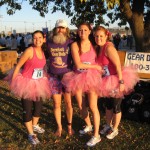
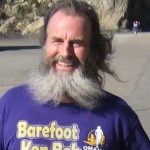
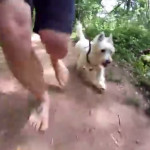
Pingback: Episode 87 Barefoot Running Experience « Anthony's Audio Journal